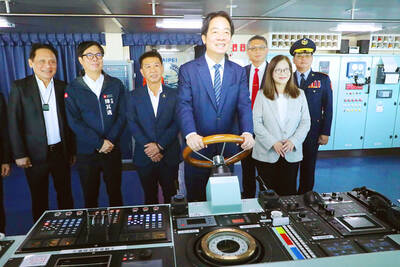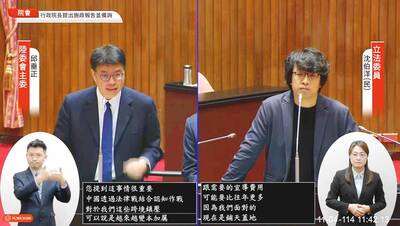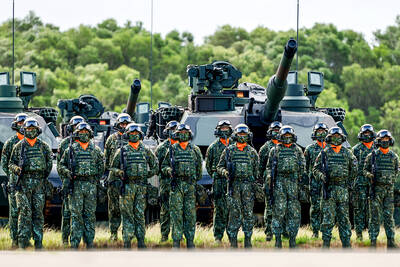A Himalayan boulder in pink, a buxom pig sculpture strutting on silver hoofs in a green dress and pearls, waist-high white porcelain penguins — these and more are on offer as three major art fairs converged on China’s commercial capital.
An explosion of art auctions and galleries both large and small is turning Shanghai, China’s biggest city, into a destination for art dealers and aficionados from around the world.
Timed to capitalize on a presumed post-Olympics surge of interest, the Shanghai Biennale, the Shanghai Art Fair and SHContemporary opened almost simultaneously last week, drawing thousands of visitors both Chinese and foreign.
“I think that it’s the growing up of Shanghai as an art center,” said Uli Sigg, a former Swiss ambassador to Beijing who began collecting Chinese art in the 1970s while working in China for Schindler Elevator.
While Shanghai lags behind Beijing as a cultural center, the city now has more than 800 galleries — part of a boom that pushed sales at Chinese auctions last year to nearly 22 billion yuan (US$3.2 billion), up about 35 percent from the year before.
Some say the craze for Chinese art is fueling a “bubble” in art prices that is bound to collapse eventually. But most works on offer at the recent art fairs are priced in the tens of thousands of yuan — within the modest means of many newly affluent local collectors.
Visitors to Shanghai’s art fairs are faced with a choice of just about any genre and theme.
At the Biennale, iridescent fiberglass ants climb the red brick walls of downtown’s Shanghai Art Museum, while inside a gleaming white and silver “Flying Machine,” created from an airplane, a sedan and a tractor, more obviously reflects the fair’s theme of “translocomotion.”
Just down the road at the Shanghai Exhibition Center, 120 galleries from 20 countries are displaying works both Chinese and foreign at SHContemporary.
“We see everywhere in this world great contemporary artists and especially this continent of Asia is growing in a stunning way,” said Lorenzo Rudolf, director of the show.
Some exhibitors fretted over pieces they felt were overpriced.
“Chinese art is the flavor of the month, so people will buy at all sorts of prices,” said Peter Micic of Beijing Central Art Gallery. “But rip-offs devalue quality art.”
Sigg agreed.
“The quality of this art, the interest, is not the main factor driving the value,” he said.
He blamed the influential role of auctions and the market’s hefty appetite for “fresh flesh.”
“The average price level may not be sustainable,” Sigg said.

CALL FOR SUPPORT: President William Lai called on lawmakers across party lines to ensure the livelihood of Taiwanese and that national security is protected President William Lai (賴清德) yesterday called for bipartisan support for Taiwan’s investment in self-defense capabilities at the christening and launch of two coast guard vessels at CSBC Corp, Taiwan’s (台灣國際造船) shipyard in Kaohsiung. The Taipei (台北) is the fourth and final ship of the Chiayi-class offshore patrol vessels, and the Siraya (西拉雅) is the Coast Guard Administration’s (CGA) first-ever ocean patrol vessel, the government said. The Taipei is the fourth and final ship of the Chiayi-class offshore patrol vessels with a displacement of about 4,000 tonnes, Lai said. This ship class was ordered as a result of former president Tsai Ing-wen’s (蔡英文) 2018

‘SECRETS’: While saying China would not attack during his presidency, Donald Trump declined to say how Washington would respond if Beijing were to take military action US President Donald Trump said that China would not take military action against Taiwan while he is president, as the Chinese leaders “know the consequences.” Trump made the statement during an interview on CBS’ 60 Minutes program that aired on Sunday, a few days after his meeting with Chinese President Xi Jinping (習近平) in South Korea. “He [Xi] has openly said, and his people have openly said at meetings, ‘we would never do anything while President Trump is president,’ because they know the consequences,” Trump said in the interview. However, he repeatedly declined to say exactly how Washington would respond in

WARFARE: All sectors of society should recognize, unite, and collectively resist and condemn Beijing’s cross-border suppression, MAC Minister Chiu Chui-cheng said The number of Taiwanese detained because of legal affairs by Chinese authorities has tripled this year, as Beijing intensified its intimidation and division of Taiwanese by combining lawfare and cognitive warfare, the Mainland Affairs Council (MAC) said yesterday. MAC Minister Chiu Chui-cheng (邱垂正) made the statement in response to questions by Democratic Progressive Party (DPP) Legislator Puma Shen (沈柏洋) about the government’s response to counter Chinese public opinion warfare, lawfare and psychological warfare. Shen said he is also being investigated by China for promoting “Taiwanese independence.” He was referring to a report published on Tuesday last week by China’s state-run Xinhua news agency,

‘NOT SUBORDINATE’: Only Taiwanese can decide the nation’s future, and people preserving their democratic way of life is not a provocation, President William Lai said Taiwan does not want China’s “one country, two systems,” and must uphold its freedom and democracy as well as resolve to defend itself, President William Lai (賴清德) said yesterday, rejecting Beijing’s latest bid to bring the country under Chinese control. The president made the remarks while attending a commissioning ceremony for Taiwan’s first battalion of M1A2T Abrams tanks in Hsinchu County’s Hukou Township (湖口). The tanks are made by General Dynamics, a major US defense contractor. China this week said it “absolutely will not” rule out using force over Taiwan, striking a much tougher tone than a series of articles in state media